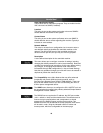
Instruction Manual
18
Other identification details
These values are for information purposes. They are visible from the
VNC client and via SNMP (if enabled).
Location
This string is sent as the system.sysLocation value over SNMP. It
should describe the location of this system.
Contact Name
This string is sent as the system.sysContact value over SNMP. It
should describe who to contact regarding this machine. Typically it
includes an email address.
Network Address
This value is not used in our configuration, but is meant to store a
user-defined value that identifies the controlled machine on the
network. The official DNS name of the controlled machine is a
obvious value to put here, but you may use it for any purpose.
Description
A user-defined description for the controlled machine.
This menu allows you to configure a number of settings, including
changing the default password for admin (recommended). Read and
consider the comments and instructions on this menu before making
any changes, as changing these features could make the unit
inaccessible through Web configuration (i.e. due to firewall filtering).
Note that any password changes you make will have to be entered in
duplicate to prevent the chance for error.
The Compatibility menu offers features that may offer enhanced
functionality with certain KVM and power products, such as
StarTech.com’s Remote Power Switch (PCM8155HNA). These can
be left at their default values if you are not connecting the unit to a
KVM or power management device.
The SNMP menu allows you to configure the SV1115IPEXT so it can
be recognized and managed using industry-standard Simple Network
Management Protocol software.
The RADIUS server requires the IP address, the UDP port number
(1812 - default or 1645) and the shared secret. The shared secret is
used to encrypt communications and corresponds to a shared
password for the RADIUS server and the client machine. Two
additional servers may be defined for backup purposes. Each server
will be tried in order, using the indicated number of retries and
timeout period, which are configurable on the same page.


















